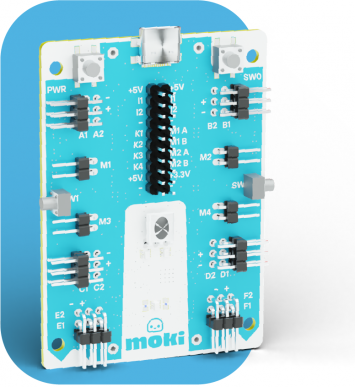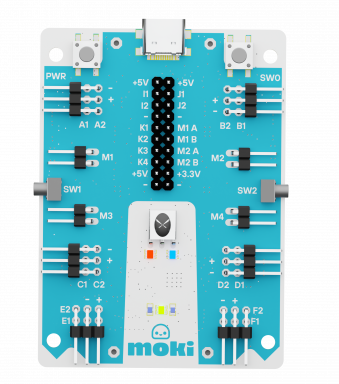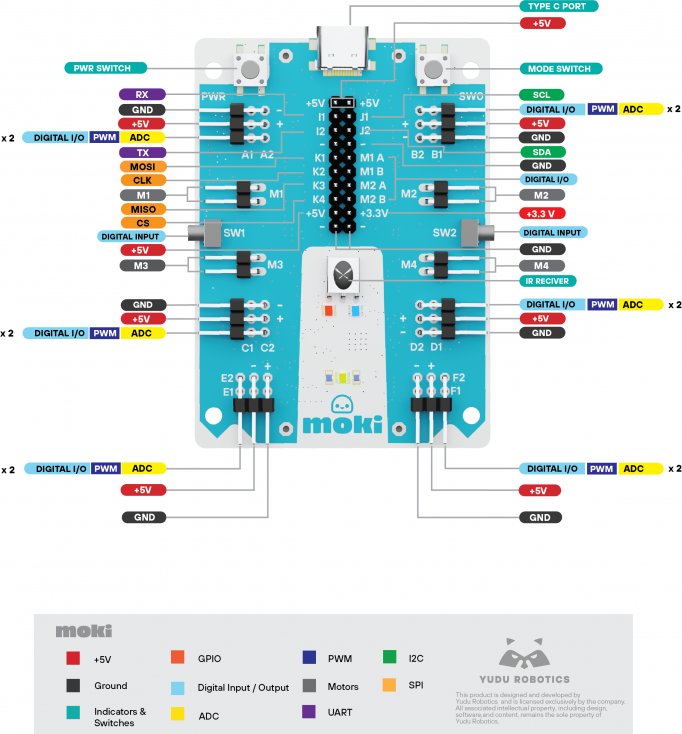Moki
Moki is a development board created by Yudu Robotics, designed for applications in robotics, automation, and embedded systems. It is built around a dual-core 32-bit microprocessor and provides multiple communication interfaces, including UART, I2C, SPI, Wi-Fi, and Bluetooth Low Energy (BLE). The board features four on board H-bridges for motor control, supporting up to four DC motors, along with twelve dedicated servo ports for precise actuator control. A built-in infrared (IR) receiver allows for remote operation, and an integrated dual 18650 Li-Ion battery system provides untethered power supply.Moki includes 12-channel 12-bit ADC support, enabling analog sensor integration. The GPIO pins can be configured for digital input, output, and PWM functionality. With support for multiple power sources, including USB Type-C and battery operation, the board can be used in both stationary and mobile systems.Moki is designed for projects that require real-time processing, wireless communication, and motor/actuator control, making it suitable for robotics, IoT-based automation, and other embedded applications.
Distinguishing Features
Moki is designed with a focus on robotics and automation, integrating a dual-core 32-bit processor, built-in motor drivers, and wireless connectivity in a compact form factor. It includes four onboard H-bridges for motor control, twelve dedicated servo ports for multi-axis movement, and a dual 18650 Li-Ion battery system for standalone operation.
The board features an integrated IR receiver for remote control and supports Wi-Fi and Bluetooth Low Energy (BLE) for wireless communication. Its processing capabilities, real-time control support, and multiple peripheral interfaces make it suitable for applications involving motor control, automation, and embedded systems.
Features
Moki is designed to provide a versatile and efficient platform for robotics and embedded system development. Its powerful dual-core processor, integrated motor control capabilities, and extensive connectivity options make it ideal for both prototyping and real-world applications. With built-in power management, multiple communication interfaces, and dedicated servo support, Moki enables seamless integration with a wide range of sensors, actuators, and wireless modules. Below are the key features of the development board:
Controller:
Memory:
FlashROM
Power:
|
Board Features:
· On board four H bridges for connecting motors M1, M2, M3 and M4
· Built in IR receiver
· Twelve dedicated servo ports
Ratings:
| Symbol | Description | Min | Max | Unit |
|---|---|---|---|---|
| - | Max current output from individual GPIO | - | 20mA | I |
| - | Max input voltage to GPIO | 3.6 | V | |
| M1,2,3,4 | Max load current H Bridge can deliver each channel | 2.1 | A | |
| - | Thermal limits for the whole board | 5 | 60 | °C |
Hardware Overview
Pin Out Details:
| SL No | PIN | Type | Function |
|---|---|---|---|
| 1 | A1 | ADC, Digital I/O, PWM | Dedicated direct drive servo connector |
| 2 | A2 | ADC, Digital I/O, PWM | Dedicated direct drive servo connector |
| 3 | B1 | ADC, Digital I/O, PWM | Dedicated direct drive servo connector |
| 4 | B2 | ADC, Digital I/O, PWM | Dedicated direct drive servo connector |
| 5 | C1 | ADC, Digital I/O, PWM | Dedicated direct drive servo connector |
| 6 | C2 | ADC, Digital I/O, PWM | Dedicated direct drive servo connector |
| 7 | D1 | ADC, Digital I/O, PWM | Dedicated direct drive servo connector |
| 8 | D2 | ADC, Digital I/O, PWM | Dedicated direct drive servo connector |
| 9 | E1 | ADC, Digital I/O, PWM | Dedicated direct drive servo connector |
| 10 | E2 | ADC, Digital I/O, PWM | Dedicated direct drive servo connector |
| 11 | F1 | ADC, Digital I/O, PWM | Dedicated direct drive servo connector |
| 12 | F2 | ADC, Digital I/O, PWM | Dedicated direct drive servo connector |
| 13 | I1 | RX | UART RX Line |
| 14 | I2 | TX | UART TX Line |
| 15 | J1 | SCL | I2C Serial clock line |
| 5 | J2 | SDA | I2C Data line |
| 17 | K1 | MOSI | SPI, Master Out Slave In |
| 18 | K2 | CLK | SPI, Serial Clock |
| 19 | K3 | MISO | SPI, Master In Slave Out |
| 20 | K4 | CS | SPI, Chip Select |
| 21 | M1A | Digital I/O | Shared line with H Bridge IC |
| 22 | M1B | Digital I/O | Shared line with H Bridge IC |
| 23 | M2A | Digital I/O | Shared line with H Bridge IC |
| 24 | M2B | Digital I/O | Shared line with H Bridge IC |
| 25 | SW1 | Digital Input | User programmable switch |
| 26 | SW2 | Digital Input | User programmable switch |
Pin Description
Moki includes a set of multipurpose I/O pins, communication interfaces, and motor control pins for various applications.
I/O Pins
Moki has eight multipurpose I/O pins labeled A1, A2, B1, B2, C1, C2, D1, and D2, which support the following functions:
- ADC (Analog-to-Digital Converter): These pins can be used as analog input channels for reading varying voltage levels from sensors such as temperature sensors and potentiometers.
- Digital I/O (Input/Output): Each pin can function as a digital input (HIGH/LOW states) or a digital output to control components such as LEDs, relays, or actuators.
- PWM (Pulse Width Modulation): These pins support PWM output for applications such as motor speed control, LED dimming, and servo positioning.
UART Communication
Moki includes dedicated UART (Universal Asynchronous Receiver-Transmitter) communication pins, labeled I1 (RX) and I2 (TX), for serial communication with external devices.
- I1 (RX): Used to receive serial data from external devices such as GPS modules, microcontrollers, or computers via a USB-to-serial adapter.
- I2 (TX): Used to transmit serial data to peripherals such as Bluetooth modules, Wi-Fi modules, or other UART-compatible devices.
SPI Communication
Moki provides dedicated SPI (Serial Peripheral Interface) communication pins, labeled K1 (MOSI), K2 (CLK), K3 (MISO), and K4 (CS), for high-speed data transfer with external peripherals.
- K1 (MOSI) – Master Out Slave In: Transmits data from Moki (master) to SPI slave devices such as displays and memory modules.
- K2 (CLK) – Serial Clock: Provides the clock signal for SPI communication.
- K3 (MISO) – Master In Slave Out: Receives data from SPI slave devices.
- K4 (CS) – Chip Select: Enables or disables communication with specific SPI devices.
Motor Control Pins
Moki includes four motor control pins, labeled M1A, M1B, M2A, and M2B, which are shared with the onboard H-Bridge motor driver. These pins enable direct control of DC motors, stepper motors, or other actuators.
- M1A & M1B – Motor 1 Control Pins
- M2A & M2B – Motor 2 Control Pins
Motor control functionality is determined by the digital I/O states:
- Setting one pin HIGH and the other LOW rotates the motor in one direction.
- Reversing the HIGH/LOW states rotates the motor in the opposite direction.
- Setting both pins LOW stops the motor.
- Setting both pins HIGH enables braking, depending on the motor driver configuration.
User-Programmable Switches
Moki includes two dedicated digital input switches, labelled SW1 and SW2, which can be configured for various functions.
- SW1 – Digital Input: Can be used for user interactions, such as toggling modes, starting/stopping operations, or triggering specific functions.
- SW2 – Digital Input: Can be assigned to control system behaviours, reset parameters, or navigate through menus.
Software Support
Moki is compatible with PLODE, a software platform developed by Yudu Robotics for programming, controlling, and monitoring robotic devices. PLODE provides an interface for writing and executing code, managing connectivity, and configuring Moki’s hardware features such as motor control, servo operation, and sensor integration.
Features
- Wireless Connectivity: Supports communication with Moki via Wi-Fi and Bluetooth Low Energy (BLE) for remote programming and control.
- Programming Interface: Provides an environment for writing and uploading code to Moki, allowing control over actuators, motors, and sensors.
- Real-Time Monitoring: Displays device status, including battery levels, active connections, and sensor data.
- Servo and Motor Control: Interfaces with Moki’s H-Bridge motor drivers and dedicated servo ports, enabling direct motion control.
- GPIO and Communication Management: Configures ADC, UART, I2C, and SPI interfaces for external device integration.
Usage
- Installation: PLODE is available for Android, iOS, and web platforms. Users can download and install the application to begin using Moki.
- Device Setup: Moki can be connected wirelessly to PLODE for configuration, programming, and real-time control.
- Programming & Deployment: Users can write, test, and execute code directly through PLODE’s interface, enabling customized automation and robotics applications.
PLODE serves as the primary software tool for Moki, offering an integrated environment for development, testing, and deployment of robotic functions.
For more information, go to PLODE.
Applications
Moki is designed for robotics and motion control applications, integrating onboard motor drivers, servo control, and wireless communication to support a wide range of robotic projects. With dedicated servo ports and H-bridge motor drivers, it allows precise control over actuators, motors, and sensors, making it suitable for applications that require coordinated movement and automation. The board can handle projects requiring up to 12 servos for multi-axis articulation and 4 DC motors for propulsion or additional actuation, enabling its use in humanoid robots, robotic arms, quadrupeds, and other motion-based systems. Its connectivity options, power management, and real-time processing capabilities further enhance its versatility in embedded system development and autonomous robotic platforms.
12 DOF Humanoid Robot
Developed in-house by Yudu Robotics, this humanoid robot utilizes Moki’s twelve dedicated servo ports for precise joint articulation, enabling coordinated limb movement. The onboard H-bridge motor drivers support additional actuation, making it suitable for dynamic motion applications.
6 DOF Bipedal Robot
Designed by Yudu Robotics, this bipedal robot incorporates PWM-based servo control for real-time gait balancing and adaptive movement. Moki’s processing capabilities and sensor compatibility enable stability corrections and smooth walking algorithms.
8 DOF Quadruped Robot
Built by Yudu Robotics, this quadruped robot is designed for coordinated leg movement and weight distribution. Moki’s multiple servo outputs and motor control capabilities allow for terrain-adaptive walking patterns, with wireless connectivity for remote operation and monitoring.
4 DOF Robotic Arm
Developed by Yudu Robotics, this robotic arm features precise joint positioning and speed control powered by Moki’s PWM-based servo outputs. The SPI/I2C interfaces enable integration with external sensors for object detection and manipulation, while its battery operation makes it suitable for mobile applications.
Tracked and Wheeled Robots
Yudu Robotics' in-house wheeled robots utilize Moki’s four H-bridge motor drivers, allowing independent control of dual-motor drive systems. These robots support omnidirectional movement using mecanum wheels, enabling advanced mobility. The system also integrates sensors for autonomous navigation and obstacle avoidance.
Comparison with Similar Development Boards
| Feature | Moki | Arduino Mega 2560 | Raspberry Pi Pico | ESP32 DevKit |
|---|---|---|---|---|
| Processor | Dual-core 32-bit microprocessor | ATmega2560 (8-bit) | RP2040 (Dual-core Cortex-M0+) | Dual-core Xtensa LX6 (32-bit) |
| Clock Speed | Up to 240 MHz | 16 MHz | 133 MHz | 240 MHz |
| Memory (SRAM / Flash) | 512 KB / 8 MB | 8 KB / 256 KB | 264 KB / 2 MB | 520 KB / 4 MB |
| Motor Drivers | 4 onboard H-bridges | External motor driver required | External motor driver required | External motor driver required |
| Servo Ports | 12 dedicated ports | Requires external module | Requires external module | Requires external module |
| Connectivity | Wi-Fi, BLE | None | None | Wi-Fi, BLE |
| ADC Channels | 12 (12-bit) | 16 (10-bit) | 3 (12-bit) | 18 (12-bit) |
| Power Supply | USB Type-C, Dual 18650 Li-Ion battery | USB Type-B, External power jack | Micro-USB, External power | Micro-USB, Li-Po battery support |
| GPIO Pins | Multiple, supports ADC, PWM, Digital I/O | 54 Digital, 15 PWM | 26 GPIO, 16 PWM | 34 GPIO, 16 PWM |
| Communication Interfaces | UART, I2C, SPI | UART, I2C, SPI | UART, I2C, SPI | UART, I2C, SPI |
| Form Factor | Compact, Robotics-focused | Large, general-purpose | Small, low-power | Medium, IoT-focused |
Frequently Asked Questions (FAQs)
1.Does Moki support wireless communication?
Yes, Moki supports Wi-Fi and Bluetooth Low Energy (BLE).
2.How many motors and servos can Moki control?
Moki includes four onboard H-bridges for motor control and twelve dedicated servo ports.
3.What power sources does Moki support?
Moki can be powered via USB Type-C or a built-in dual 18650 Li-Ion battery system.
4.What software is compatible with Moki?
Moki is compatible with PLODE, a programming interface for robotic devices.
5.What programming languages does Moki support?
Moki supports multiple programming environments based on the firmware used.
6.How do I update the firmware on Moki?
Firmware updates can be done through PLODE or via USB flashing.
7.Does Moki support external peripherals?
Yes, Moki includes ADC, UART, I2C, and SPI interfaces for sensor and device connectivity.
8.Can Moki be used for IoT applications?
Yes, Moki supports wireless communication, making it suitable for IoT-based automation.


